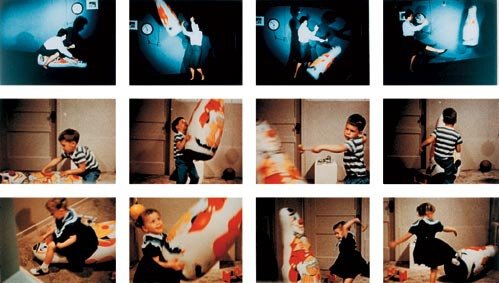The Bobo Doll Experiment and Aggressiveness

Between 1961 and 1963, Canadian psychologist Albert Bandura conducted an experiment to analyze children’s behavior when they saw adults being aggressive towards a doll. As a matter of fact, the Bobo doll experiment is the empirical demonstration of one of his most famous theories: Social Learning Theory.
This theory states that humans mostly learn by being in contact with their social environment. By observing others, we acquire certain knowledge, skills, strategies, beliefs, and attitudes. Thus, children learn about the usefulness, convenience, and consequences of different behaviors by observing adults. Consequently, they act in accordance with what they believe they should expect as a result of their actions.
Bandura’s research
Many consider Albert Bandura one of the most important figures in the social learning field. A study he conducted in 2002 placed Bandura in fourth place among the most cited psychologists of all time after Skinner, Freud, and Piaget.
Bandura didn’t agree with behaviorists’ position because he considered that they underestimated the social dimensions of human behavior. Therefore, he focused on the interaction between the learner and their environment to explain learning processes.
In 1961, Bandura began to analyze different methods to treat excessively aggressive children, identifying the origins of the violence through their behaviors. To do this, he conducted the Bobo doll experiment. Let’s see what it was all about.

The Bobo doll experiment
Albert Bandura, with the aim of providing an empirical basis for his theory, came up with this experiment. The results he obtained changed the world of psychology. In reality, the Bobo doll experiment was instrumental in exploring aggressive behavior in children.
He sought to demonstrate that children learned certain behaviors by imitating adults. 36 boys and 36 girls between the ages of 3 and 5 participated in his experiment. They were all students at the Bing Nursery School at Stanford University.
Bandura divided the children into three groups. He also divided them by sex (boys and girls). 24 were exposed to the aggressive scenario, 24 to the non-aggressive scenario, and the rest of the children to the control group. Moreover, the researchers made sure that half of the children witnessed the actions of adults of their same sex and the other half those of the opposite sex.
Each child in the aggressive and non-aggressive group individually observed an adult’s behavior towards the Bobo doll (a plastic, inflatable doll that, when balanced, regained its stability).
In the aggressive model scenario, the adult began by playing with the toys in the room for about a minute. After this time, they initiated an aggressive behavior towards the doll, punching it or using a toy hammer to hit it in the face.
“Fortunately, most human behavior is learned observationally through modeling.”
-Albert Bandura-
In the non-aggressive scenario, the adult just played with the doll. And finally, the children in the control group didn’t observe anything.
Then, the children went one by one to the room where the toys and the Bobo doll were. The researchers proceeded to record the children’s behaviors. They wanted to be able to deeply study their behaviors after having observed the adults.

Conclusions
Bandura determined the children exposed to the aggressive scenario during the Bobo doll experiment were more likely to be physically aggressive than those who were exposed to the other scenario.
Regarding the results surrounding gender differences, they strongly supported Bandura’s prediction. He discovered that children were certainly more influenced by models of their same gender.
Additionally, among the children exposed to the aggressive model scenario, boys showed a greater number of physical attacks than girls. In other words, children showed more aggressiveness after witnessing aggressive behavior from male models.
On the other hand, in the year 1965, researchers conducted a similar experiment to establish the effects of rewarding or punishing violent behavior. The conclusions they obtained validated the theory of observational learning. Basically, when adults were rewarded for their violent behavior, children were more likely to continue hitting the doll. However, when the adults were reprimanded, the children stopped hitting the Bobo doll.
As you can see, children tend to imitate what they see. For this reason, it’s very important to be careful when it comes to our behaviors and attitudes in both the family and educational environment.
“Children receive direct instruction from time to time about the appropriateness of various social comparisons.”
-Albert Bandura-
This text is provided for informational purposes only and does not replace consultation with a professional. If in doubt, consult your specialist.








